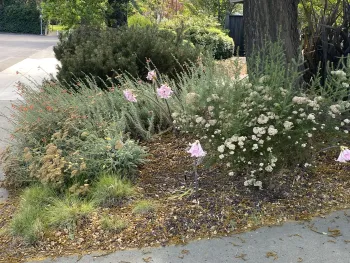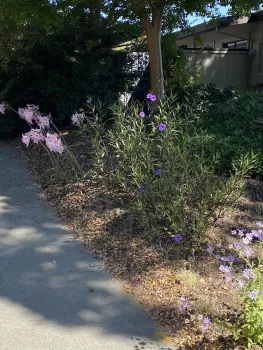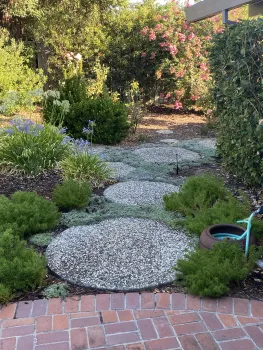
Article and photos by Kate Bear
This is the third of three articles on transitions of my yard. This article will focus on creating a more complex landscape to attract beneficial insects, pollinators, lizards, and birds. Goals include selecting low water use plants, increasing the variety of plants and visual interest, and having fun with color and design.
When deciding what to plant, I check information on the expected height, width, and sun and water needs, which are often printed on a tag on or in the plant pot. This allows me to plant different species with similar sun and water needs together in an area, and to combine different plants to create a block of color and height.
Front Yard
The front yard is rather large and includes a central planting area with a tall Chinese tallow tree between the driveway and a front walkway. A few pittosporum shrubs were removed to make way for a variety of new plants. Growing under the tree, all of the new plants receive filtered sunlight.

The rice flower bush (Ozothamnus diosmifolius) has tiny pinkish white flowers in the early spring and feathery bright green leaves. The naked lady lily bulbs produce bright green foliage in the winter, and are now blooming with pink flowers on bare stems. The fuchsia (Epilobium canum) and yarrow (Achillea hybrids) are quite established after one year. The yarrow provides a bright yellow splash of springtime color and attracts many beneficial insects. The taller California fuchsia has bright red flowers in late summer and is now attracting hummingbirds. The buffalo grass (Bouteloua gracilis) plants are beginning to merge into a group as they get established. The irises are low water use California natives that grow from rhizomes, with strap shaped leaves and flowers that bloom in spring in a variety of colors including white, yellow, lavender, and purple.
Also planted in the front yard in full sun is a native manzanita (Arctostaphylos uva-ursi) shrub, which was placed near a neighbor’s mature manzanita to enable bees to visit lots of the small bell-shaped flowers within a short distance when they bloom in the spring. It will mature into a shrub about four to five feet tall and wide. This plant can handle hot summer temperatures and doesn’t require a lot of water to do well.
Another sun-loving and heat-tolerant plant that we discovered is the blue Mexican petunia (Ruellia brittoniana). It has a somewhat lacy appearance, with visible stems and smaller leaves. Each day, an entirely new crop of deep purple flowers is produced. Bees enjoy visiting this plant, and its mature size is expected to reach about three feet tall by three feet wide.
Back Yard
Leading into the back yard from a patio are a number of very large round paving stones. Silver carpet (Dymondia margaretae), a very flat ground cover, was planted around them to fill the gaps between. This species can handle some foot traffic and does well in full sun with low water. It produces small daisy-like yellow flowers in spring and summer. Next to the Dymondia, lavender cotton (Santolina virens) was placed to create an area of eight-inch-tall plants between the ground cover and larger perennials. It thrives in full sun with low water, and the plants have filled in nicely.

The center of our backyard is a particularly challenging area. Two birch trees that provided much-needed shade died and required removal. Now, this area receives all day sun and is quite hot in summer afternoons. Two years ago, a desert willow tree (Chilopsis linearis ‘Bubba’) was planted to replace the birch trees. Last year, it nearly died due to heat and insufficient water, so this year we are working to restore it to good health and get it growing robustly. Even though this species is adapted to the desert, it needs ample water and shade protection for now while it is getting established and recovering from last year’s stressful summer.
Large and small perennials surround the desert willow. They include a rose, large and small agapanthus plants with both blue and white flowers, a fortnight lily, lavender, boxwood shrubs, and purple dome aster, Monch aster, Oenothera, and Erigeron.
A mature redwood tree shades the back several feet of our back yard and grows on the property behind us. On our side of the fence, under the redwood is a pittosporum shrub that we are letting grow taller to hide the fence and fill in the area under the redwood tree branches. Next to the pittosporum grows a young crape myrtle tree that is blooming beautifully. Barberry plants grow under the crape myrtle and the redwood and get morning sun and afternoon shade. Two years ago, I planted a dwarf lime tree in front of the crape myrtle, and although it is immature, it produced limes last year.
It has been very enjoyable to watch the changes in the front and backyard with the addition of new plants. I’ve learned a tremendous amount about what plants need to get established in our new home. I hope this information inspires fellow gardeners who are also transitioning their yards.
If you missed the first and second parts of this article, you can read them here -
